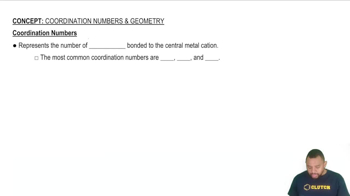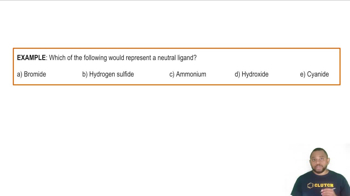Ch.23 - Transition Metals and Coordination Chemistry

Brown15th EditionChemistry: The Central ScienceISBN: 9780137542970Not the one you use?Change textbook
Chapter 23, Problem 26
Complete the exercises below. Indicate the coordination number and the oxidation number of the metal for each of the following complexes: e. NH₄[Cr(NH₃)₂(NCS)₄]
 Verified step by step guidance
Verified step by step guidance1
Step 1: Identify the central metal atom in the complex. In the given complex NH₄[Cr(NH₃)₂(NCS)₄], the central metal atom is Chromium (Cr).
Step 2: Determine the coordination number of the metal. The coordination number is the number of ligand donor atoms bonded to the central metal. In this complex, there are 2 ammonia (NH₃) ligands and 4 thiocyanate (NCS) ligands, making a total of 6 ligands. Therefore, the coordination number of Cr is 6.
Step 3: Determine the charge of the complex ion. The complex ion is [Cr(NH₃)₂(NCS)₄]. Ammonia (NH₃) is a neutral ligand, and thiocyanate (NCS) is a monodentate ligand with a charge of -1. Since there are 4 NCS ligands, the total negative charge contributed by NCS is -4.
Step 4: Calculate the oxidation number of the metal. The overall charge of the complex ion [Cr(NH₃)₂(NCS)₄] is balanced by the NH₄⁺ ion, which has a charge of +1. Therefore, the charge of the complex ion must be -1 to balance the +1 charge of NH₄⁺. Let the oxidation number of Cr be x. The equation is: x + 0 (from NH₃) + (-4) (from NCS) = -1.
Step 5: Solve for the oxidation number of Cr. Rearrange the equation from Step 4: x - 4 = -1. Solving for x gives the oxidation number of Cr as +3.
Key Concepts
Here are the essential concepts you must grasp in order to answer the question correctly.
Coordination Number
The coordination number refers to the number of ligand atoms that are directly bonded to a central metal atom in a coordination complex. In the given complex, NH₄[Cr(NH₃)₂(NCS)₄], the coordination number is determined by counting the total number of donor atoms from the ligands surrounding the chromium ion.
Recommended video:
Guided course

Coordination Numbers
Oxidation Number
The oxidation number indicates the degree of oxidation of an atom in a compound, reflecting the number of electrons lost or gained. For the metal in the complex, the oxidation number can be calculated by considering the charges of the ligands and the overall charge of the complex, which helps in determining the charge on the chromium ion.
Recommended video:
Guided course

Oxidation Numbers
Ligands
Ligands are ions or molecules that can donate a pair of electrons to a central metal atom to form a coordination complex. In the complex NH₄[Cr(NH₃)₂(NCS)₄], NH₃ (ammonia) and NCS⁻ (thiocyanate) are the ligands, and their nature and charge influence both the coordination number and the oxidation state of the metal.
Recommended video:
Guided course

Ligands Example
Related Practice
